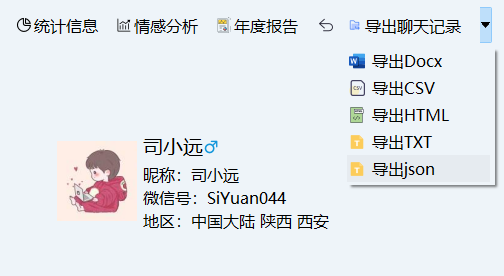导出json格式的聊天记录。
如果你想合并多个联系人的数据,可以直接运行下面的代码合并
import json
import os
data_dir = r'E:\Project\Python\MemoTrace\data\聊天记录'
dev_res = []
train_res = []
for filepath, dirnames, filenames in os.walk(data_dir):
for filename in filenames:
if filename.endswith('.json'):
print(filename, filepath)
filepath_ = os.path.join(filepath, filename)
with open(filepath_, 'r', encoding='utf-8') as f:
data = json.load(f)
if data:
if filename.endswith('train.json'):
train_res += data
else:
dev_res += data
with open('train.json', 'w', encoding='utf-8') as f:
json.dump(train_res, f, ensure_ascii=False, indent=4)
with open('dev.json', 'w', encoding='utf-8') as f:
json.dump(dev_res, f, ensure_ascii=False, indent=4)你现在应该有两个文件,dev.json(验证集)和train.json(训练集)
下载地址:https://github.com/THUDM/ChatGLM3
首先需要下载本仓库:
git clone https://github.com/THUDM/ChatGLM3
cd ChatGLM3然后使用 pip 安装依赖:
pip install -r requirements.txt
- 为了保证
torch的版本正确,请严格按照 官方文档 的说明安装。 - 如果遇到问题,请参照ChatGLM3项目的解决方案,不要在本项目中提问
本目录提供 ChatGLM3-6B 模型的微调示例,包括全量微调和 P-Tuning v2。格式上,提供多轮对话微调样例和输入输出格式微调样例。
如果将模型下载到了本地,本文和代码中的 THUDM/chatglm3-6b 字段均应替换为相应地址以从本地加载模型。
运行示例需要 python>=3.10,除基础的 torch 依赖外,示例代码运行还需要依赖。
pip install -r requirements.txt我们仅提供了单机多卡/多机多卡的运行示例,因此您需要至少一台具有多个 GPU 的机器。本仓库中的默认配置文件中,我们记录了显存的占用情况:
- SFT 全量微调: 4张显卡平均分配,每张显卡占用
48346MiB显存。 - P-TuningV2 微调: 1张显卡,占用
18426MiB显存。 - LORA 微调: 1张显卡,占用
14082MiB显存。
请注意,该结果仅供参考,对于不同的参数,显存占用可能会有所不同。请结合你的硬件情况进行调整。
请注意,我们仅仅使用英伟达 Hopper(代表显卡:H100) 和 Ampère(代表显卡:A100) 架构和系列显卡做过测试。如果您使用其他架构的显卡,可能会出现
- 未知的训练问题 / 显存占用与上述有误差。
- 架构过低而不支持某些特性。
- 推理效果问题。 > 以上三种情况为社区曾经遇到过的问题,虽然概率极地,如果您遇到了以上问题,可以尝试在社区中解决。
多轮对话微调示例采用 ChatGLM3 对话格式约定,对不同角色添加不同 loss_mask 从而在一遍计算中为多轮回复计算 loss。
对于数据文件,样例采用如下格式
如果您仅希望微调模型的对话能力,而非工具能力,您应该按照以下格式整理数据。
[
{
"conversations": [
{
"role": "system",
"content": "<system prompt text>"
},
{
"role": "user",
"content": "<user prompt text>"
},
{
"role": "assistant",
"content": "<assistant response text>"
},
// ... Muti Turn
{
"role": "user",
"content": "<user prompt text>"
},
{
"role": "assistant",
"content": "<assistant response text>"
}
]
}
// ...
]请注意,这种方法在微调的step较多的情况下会影响到模型的工具调用功能
system角色为可选角色,但若存在system角色,其必须出现在user角色之前,且一个完整的对话数据(无论单轮或者多轮对话)只能出现一次system角色。
这里以 AdvertiseGen 数据集为例,
您可以从 Google Drive
或者 Tsinghua Cloud 下载 AdvertiseGen 数据集。
将解压后的 AdvertiseGen 目录放到 data 目录下并自行转换为如下格式数据集。
请注意,现在的微调代码中加入了验证集,因此,对于一组完整的微调数据集,必须包含训练数据集和验证数据集,测试数据集可以不填写。或者直接用验证数据集代替。
{"conversations": [{"role": "user", "content": "类型#裙*裙长#半身裙"}, {"role": "assistant", "content": "这款百搭时尚的仙女半身裙,整体设计非常的飘逸随性,穿上之后每个女孩子都能瞬间变成小仙女啦。料子非常的轻盈,透气性也很好,穿到夏天也很舒适。"}]}
微调配置文件位于 config 目录下,包括以下文件:
ds_zereo_2 / ds_zereo_3.json: deepspeed 配置文件。lora.yaml / ptuning.yaml / sft.yaml: 模型不同方式的配置文件,包括模型参数、优化器参数、训练参数等。 部分重要参数解释如下:- data_config 部分
- train_file: 训练数据集的文件路径。
- val_file: 验证数据集的文件路径。
- test_file: 测试数据集的文件路径。
- num_proc: 在加载数据时使用的进程数量。
- max_input_length: 输入序列的最大长度。
- max_output_length: 输出序列的最大长度。
- training_args 部分
- output_dir: 用于保存模型和其他输出的目录。
- max_steps: 训练的最大步数。
- per_device_train_batch_size: 每个设备(如 GPU)的训练批次大小。
- dataloader_num_workers: 加载数据时使用的工作线程数量。
- remove_unused_columns: 是否移除数据中未使用的列。
- save_strategy: 模型保存策略(例如,每隔多少步保存一次)。
- save_steps: 每隔多少步保存一次模型。
- log_level: 日志级别(如 info)。
- logging_strategy: 日志记录策略。
- logging_steps: 每隔多少步记录一次日志。
- per_device_eval_batch_size: 每个设备的评估批次大小。
- evaluation_strategy: 评估策略(例如,每隔多少步进行一次评估)。
- eval_steps: 每隔多少步进行一次评估。
- predict_with_generate: 是否使用生成模式进行预测。
- generation_config 部分
- max_new_tokens: 生成的最大新 token 数量。
- peft_config 部分
- peft_type: 使用的参数有效调整类型(如 LORA)。
- task_type: 任务类型,这里是因果语言模型(CAUSAL_LM)。
- Lora 参数:
- r: LoRA 的秩。
- lora_alpha: LoRA 的缩放因子。
- lora_dropout: 在 LoRA 层使用的 dropout 概率
- P-TuningV2 参数:
- num_virtual_tokens: 虚拟 token 的数量。
- data_config 部分
通过以下代码执行 单机多卡/多机多卡 运行,这是使用 deepspeed 作为加速方案的,您需要安装 deepspeed。
cd finetune_demo
OMP_NUM_THREADS=1 torchrun --standalone --nnodes=1 --nproc_per_node=8 finetune_hf.py data/AdvertiseGen/ THUDM/chatglm3-6b configs/lora.yaml configs/ds_zero_2.json
通过以下代码执行 单机单卡 运行。
cd finetune_demo
python finetune_hf.py data/AdvertiseGen/ THUDM/chatglm3-6b configs/lora.yaml
如果按照上述方式进行训练,每次微调都会从头开始,如果你想从训练一半的模型开始微调,你可以加入第四个参数,这个参数有两种传入方式:
yes, 自动从最后一个保存的 Checkpoint开始训练XX, 断点号数字 例600则从序号600 Checkpoint开始训练
例如,这就是一个从最后一个保存点继续微调的示例代码
cd finetune_demo
python finetune_hf.py data/AdvertiseGen/ THUDM/chatglm3-6b configs/lora.yaml yes
您可以在 finetune_demo/inference_hf.py 中使用我们的微调后的模型,仅需要一行代码就能简单的进行测试。
python inference_hf.py your_finetune_path --prompt your prompt
这样,得到的回答就微调后的回答了。
您可以在任何一个 demo 内使用我们的 lora 和 全参微调的模型。这需要你自己按照以下教程进行修改代码。
- 使用
finetune_demo/inference_hf.py中读入模型的方式替换 demo 中读入模型的方式。
请注意,对于 LORA 和 P-TuningV2 我们没有合并训练后的模型,而是在
adapter_config.json中记录了微调型的路径,如果你的原始模型位置发生更改,则你应该修改adapter_config.json中base_model_name_or_path的路径。
def load_model_and_tokenizer(
model_dir: Union[str, Path], trust_remote_code: bool = True
) -> tuple[ModelType, TokenizerType]:
model_dir = _resolve_path(model_dir)
if (model_dir / 'adapter_config.json').exists():
model = AutoPeftModelForCausalLM.from_pretrained(
model_dir, trust_remote_code=trust_remote_code, device_map='auto'
)
tokenizer_dir = model.peft_config['default'].base_model_name_or_path
else:
model = AutoModelForCausalLM.from_pretrained(
model_dir, trust_remote_code=trust_remote_code, device_map='auto'
)
tokenizer_dir = model_dir
tokenizer = AutoTokenizer.from_pretrained(
tokenizer_dir, trust_remote_code=trust_remote_code
)
return model, tokenizer- 读取微调的模型,请注意,你应该使用微调模型的位置,例如,若你的模型位置为
/path/to/finetune_adapter_model,原始模型地址为path/to/base_model,则你应该使用/path/to/finetune_adapter_model作为model_dir。 - 完成上述操作后,就能正常使用微调的模型了,其他的调用方式没有变化。
- 微调代码在开始训练前,会先打印首条训练数据的预处理信息(默认已经注释,可以解除注释),显示为
Sanity
Check >> >> >> >> >> >> >
'[gMASK]': 64790 -> -100
'sop': 64792 -> -100
'<|system|>': 64794 -> -100
'': 30910 -> -100
'\n': 13 -> -100
'Answer': 20115 -> -100
'the': 267 -> -100
'following': 1762 -> -100
...
'know': 683 -> -100
'the': 267 -> -100
'response': 3010 -> -100
'details': 3296 -> -100
'.': 30930 -> -100
'<|assistant|>': 64796 -> -100
'': 30910 -> 30910
'\n': 13 -> 13
'I': 307 -> 307
'need': 720 -> 720
'to': 289 -> 289
'use': 792 -> 792
...
<< << << << << << < Sanity
Check
字样,每行依次表示一个 detokenized string, token_id 和 target_id。其中,target_id为token_id在模型词表中的索引,-100表示该
token 不参与 loss 计算。
_prepare_model_for_training的作用是遍历模型的所有可训练参数,并确保它们的数据类型为torch.float32。 这在某些情况下是必要的,因为混合精度训练或其他操作可能会更改模型参数的数据类型。该代码默打开,可以注释,但是如果使用half格式训练出现问题,可以切换回这个代码,显存可能增加。- 在我们的Huggingface模型代码中,有以下内容:
这可能导致训练的时候显存增加,因此,如果您的显存不足,可以尝试将
if self.gradient_checkpointing and self.training: layer_ret = torch.utils.checkpoint.checkpoint( layer, hidden_states, attention_mask, rotary_pos_emb, kv_caches[index], use_cache, use_reentrant=False )
use_reentrant修改为True。 - 微调后的模型可以使用任何支持
peft载入的模型加速框架,在这里,我们没有提供demo。 - 本仓库的微调数据集格式与 API 微调数据集格式有一定区别
- ZhipuAI API 微调数据集中的
messages字段在本仓库为conversation字段。 - ZhipuAI API 中的微调文件为
jsonl, 在本仓库,需要简单的将文件名改为json。
- ZhipuAI API 微调数据集中的
以上内容来自ChatGLM3项目
配置文件
config/lora.yaml
data_config:
train_file: train.json
val_file: dev.json
test_file: dev.json
num_proc: 10
max_input_length: 512
max_output_length: 128
training_args:
# see `transformers.Seq2SeqTrainingArguments`
output_dir: ./output03-24
max_steps: 100000
# settings for data loading
per_device_train_batch_size: 4
dataloader_num_workers: 10
remove_unused_columns: false
# settings for saving checkpoints
save_strategy: steps
save_steps: 2000
# settings for logging
log_level: info
logging_strategy: steps
logging_steps: 10
# settings for evaluation
per_device_eval_batch_size: 4
evaluation_strategy: steps
eval_steps: 5200
# settings for optimizer
# adam_epsilon: 1e-6
# uncomment the following line to detect nan or inf values
# debug: underflow_overflow
predict_with_generate: yes
# see `transformers.GenerationConfig`
generation_config:
max_new_tokens: 256
# set your absolute deepspeed path here
#deepspeed: ds_zero_2.json
# set to true if train with cpu.
use_cpu: false
peft_config:
peft_type: LORA
task_type: CAUSAL_LM
r: 8
lora_alpha: 32
lora_dropout: 0.1硬件配置:4090 24G、64G内存、CPU 14700KF 20核28线程
你需要根据你的硬件配置修改上述参数,各个参数含义上面有说
微调命令(需要指定数据集路径和ChatGLM3基础大模型的路径)
python finetune_hf.py data/ E:\\Project\\Python\\Langchain-Chatchat\\chatglm3-6b configs/lora.yaml yes在api_server.py修改微调保存路径
model, tokenizer = load_model_and_tokenizer(
r'E:\Project\Python\ChatGLM3\finetune_demo\output03-24\checkpoint-224000'
)直接运行即可
python api_server.py调用示例(你可以在任意一个支持ChatGPT的应用中使用它):
from openai import OpenAI
base_url = "http://127.0.0.1:8002/v1/"
client = OpenAI(api_key="EMPTY", base_url=base_url)
def simple_chat(use_stream=True):
messages = [
{
"role": "user",
"content": "你好啊"
}
]
response = client.chat.completions.create(
model="chatglm3-6b",
messages=messages,
stream=use_stream,
max_tokens=256,
temperature=0.8,
presence_penalty=1.1,
top_p=0.8)
if response:
if use_stream:
for chunk in response:
print(chunk.choices[0].delta.content, end='')
else:
content = response.choices[0].message.content
print(content)
else:
print("Error:", response.status_code)
if __name__ == "__main__":
simple_chat(use_stream=True)

